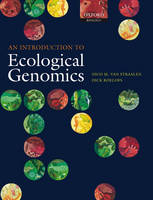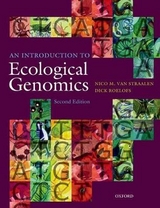
An Introduction to Ecological Genomics
Seiten
2006
Oxford University Press (Verlag)
978-0-19-856671-7 (ISBN)
Oxford University Press (Verlag)
978-0-19-856671-7 (ISBN)
- Titel erscheint in neuer Auflage
- Artikel merken
Zu diesem Artikel existiert eine Nachauflage
Incorporates various examples from microbiology, plant science, and zoology. This synthesis of the field of ecological genomics is of interest to senior undergraduate and graduate level students, as well as researchers in the fields of ecology, evolutionary biology, genetics, and molecular biology.
The genomics revolution has expanded from its origins in molecular biology to impact upon every discipline in the life sciences, including ecology. Several ecological questions can be profitably addressed using genomics technology, including issues of nutrient cycling, population structure, life-history variation, trophic interaction, stress responses and the ecological niche. "An Introduction to Ecological Genomics" focuses on three fundamental ecological questions: What is the relationship between community structure and ecological function in ecosystems? How can the variation in life-history patterns among species be explained from interaction between the genome and the environment? To what extent can the limits of the ecological niche be understood from molecular stress responses? Each of these questions is evaluated in this book, in the light of recent advances in genomics research, paying particular attention to data obtained from sequencing and screening of environmental genomes (metagenomics), microarray-based transcription profiling, and gene expression directed by signal-transduction pathways.
The chapters covering these key areas are preceded by discussions of genomics methodology and comparative genomics, and the book concludes with a chapter on integrative approaches such as ecological control analysis. An issue receiving particular attention is the genomic study of model species and the extrapolation of data obtained from them to an ecological context. The authors also provide a comparative survey the properties of genomes (genome size, gene families,synteny, polymorphism) for prokaryotes as well as the main eukaryotic models. This book incorporates a multitude of recent examples from microbiology, plant science, and zoology, drawing together a scattered literature in the first synthesis of the new and exciting field of ecological genomics. It will be of particular interest to senior undergraduate and graduate level students, as well as researchers in the fields of ecology, evolutionary biology, genetics, and molecular biology.
The genomics revolution has expanded from its origins in molecular biology to impact upon every discipline in the life sciences, including ecology. Several ecological questions can be profitably addressed using genomics technology, including issues of nutrient cycling, population structure, life-history variation, trophic interaction, stress responses and the ecological niche. "An Introduction to Ecological Genomics" focuses on three fundamental ecological questions: What is the relationship between community structure and ecological function in ecosystems? How can the variation in life-history patterns among species be explained from interaction between the genome and the environment? To what extent can the limits of the ecological niche be understood from molecular stress responses? Each of these questions is evaluated in this book, in the light of recent advances in genomics research, paying particular attention to data obtained from sequencing and screening of environmental genomes (metagenomics), microarray-based transcription profiling, and gene expression directed by signal-transduction pathways.
The chapters covering these key areas are preceded by discussions of genomics methodology and comparative genomics, and the book concludes with a chapter on integrative approaches such as ecological control analysis. An issue receiving particular attention is the genomic study of model species and the extrapolation of data obtained from them to an ecological context. The authors also provide a comparative survey the properties of genomes (genome size, gene families,synteny, polymorphism) for prokaryotes as well as the main eukaryotic models. This book incorporates a multitude of recent examples from microbiology, plant science, and zoology, drawing together a scattered literature in the first synthesis of the new and exciting field of ecological genomics. It will be of particular interest to senior undergraduate and graduate level students, as well as researchers in the fields of ecology, evolutionary biology, genetics, and molecular biology.
1. What is ecological genomics?; 2. Genome analysis; 3. Comparing genomes; 4. Structure and function in communities; 5. Life-history patterns; 6. Stress responses; 7. Integrated ecological genomics; References; Index
| Erscheint lt. Verlag | 16.3.2006 |
|---|---|
| Reihe/Serie | Oxford Biology |
| Zusatzinfo | Numerous halftones, tables, and line drawings |
| Verlagsort | Oxford |
| Sprache | englisch |
| Themenwelt | Naturwissenschaften ► Biologie ► Genetik / Molekularbiologie |
| Naturwissenschaften ► Biologie ► Ökologie / Naturschutz | |
| ISBN-10 | 0-19-856671-9 / 0198566719 |
| ISBN-13 | 978-0-19-856671-7 / 9780198566717 |
| Zustand | Neuware |
| Haben Sie eine Frage zum Produkt? |
Mehr entdecken
aus dem Bereich
aus dem Bereich
50 Meilensteine der Genetik
Buch | Hardcover (2022)
Librero b.v. (Verlag)
CHF 13,90



